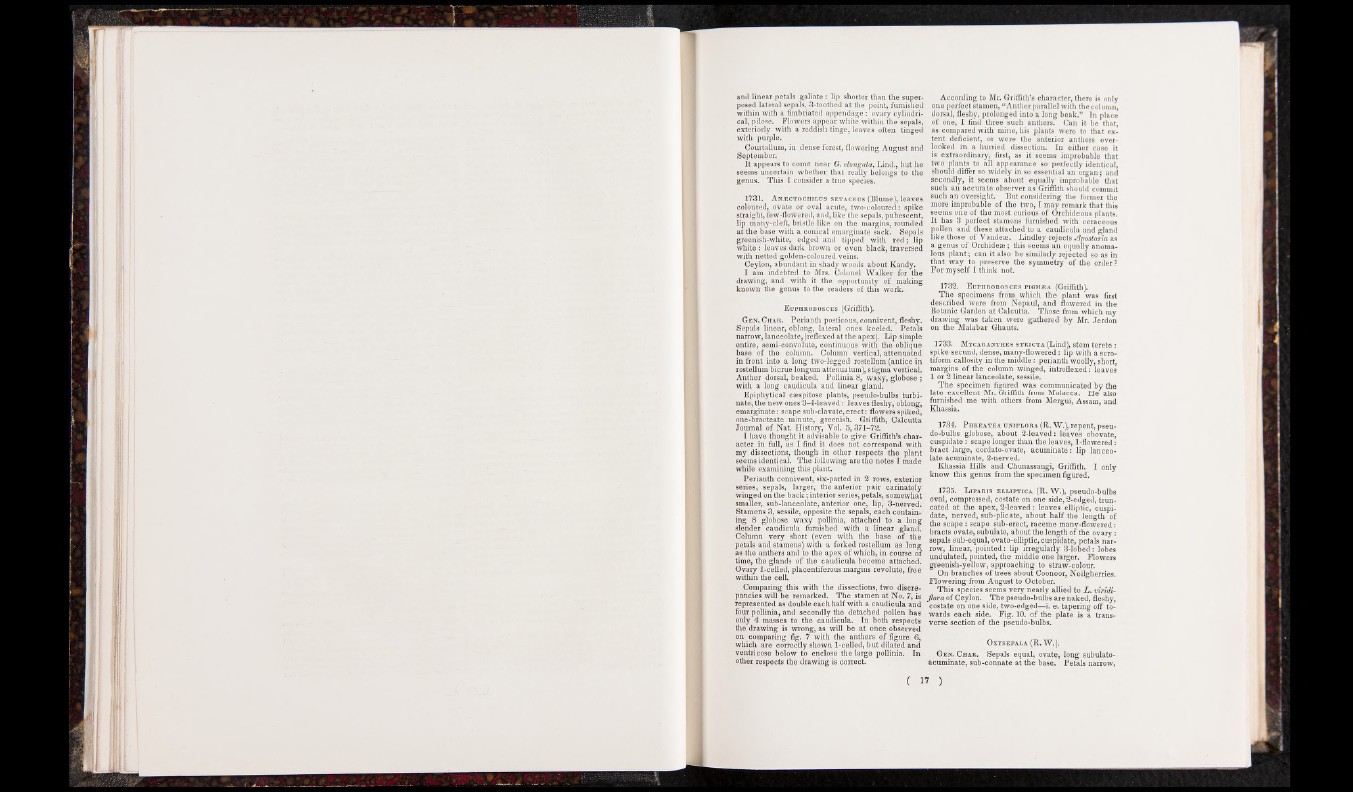
and linear petals galiate: lip shorter than the superposed
lateral sepals, 3-toothed at the point, furnished
within with a fimbriated appendage : ovary cylindrical,
pilose. Flowers appear white within the sepals,
exteriorly with a reddish tinge, leaves often tinged
with purple.
Courtallum, in dense forest, flowering August and
September.
It appears to come near G. elongata, Lind., but he
seems uncertain whether that really belongs to the
genus. This I consider a true species.
1731. An.ectochilus setaceus (Blume), leaves
coloured, ovate or oval acute, two-coloured: spike
straight, few-flowered, and, like the sepals, pubescent,
lip many-cleft, bristle like on the margins, rounded
at the base with a conical emarginate sack. Sepals
greenish-white, edged and tipped with re d ; lip
white: leaves dark brown or even black, traversed
with netted golden-coloured veins.
Ceylon, abundant in shady woods about Kandy.
I am indebted to Mrs. Colonel Walker for the
drawing, and with it the opportunity of making
known the genus to the readers of this work.
Euphrobosces (Griffith).
Gen. Char. Perianth posticous, connivent, fleshy.
Sepals linear, oblong, lateral ones keeled. Petals
narrow, lanceolate, (reflexed at the apex). Lip simple
entire, semi-convolute, continuous with the oblique
base of the column. Column vertical, attenuated
in front into a long two-legged rostellum (antice in
rostellum bicrue longum attenuatum), stigma vertical.
Anther dorsal, beaked. Pollinia 8, waxy, globose ;
with a long caudicula and linear gland.
Epiphytical csespitose plants, pseudo-bulbs turbinate,
the new ones 3-4-leaved: leaves fleshy, oblong,
emarginate: scape sub-clavate, erect: flowers spiked,
one-bracteate minute, greenish. Griffith, Calcutta
journal of Nat. History, Vol. 5, 371-72.
I have thought it advisable to give Griffith’s character
in full, as I find it does not correspond with
my dissections, though in other respects the plant
seems identical. The following are the notes I made
while examining this plant.
Perianth connivent, six-parted in 2 rows, exterior
series, sepals, larger, the anterior pair carinately
winged on the b ack ; interior series, petals, somewhat
smaller, sub-lanceolate, anterior one, lip, 3-nerved.
Stamens 3, sessile, opposite the sepals, each containing
8 globose waxy pollinia, attached to a long
slender caudicula furnished with a linear gland.
Column very short (even with the base of the
petals and stamens) with a forked rostellum as long
as the anthers and to the apex of which, in course of
time, the glands of the caudicula become attached.
Ovary 1-celled, placentiferous margins revolute, free
within the cell.
Comparing this with the dissections, two discrepancies
will be remarked. The stamen at No. 7, is
represented as double each half with a caudicula and
four pollinia, and secondly the detached pollen has
only 4 masses to the caudicula. In both respects
the drawing is wrong, as will be at once observed
on comparing fig. 7 with the anthers of figure 6,
which are correctly shown 1-celled, but dilated and
ventricose below to enclose the large pollinia. In
other respects the drawing is correct.
According to Mr. Griffith’s character, there is only
one perfect stamen, “Anther parallel with the column,
dorsal, fleshy, prolonged into a long beak.” In place
of one, I find three such anthers. Can it be that,
as compared with mine, his plants were to that extent
deficient, or were the anterior anthers overlooked
in a hurried dissection. In either case it
is extraordinary, first, as it seems improbable that
two plants to all appearance so perfectly identical,
should differ so widely in so essential an organ; and
secondly, it seems about equally improbable that
such an accurate observer as Griffith should commit
such an oversight. But considering the former the
more improbable of the two, I may remark that this
seems one of the most curious of Orchideous plants.
It has 3 perfect stamens furnished with ceraceous
pollen and these attached to a caudicula and gland
like those of Vandeae. Lindley rejects Apostasia as
a genus of Orchideae; this seems an equally anomalous
plant; can it also be similarly rejected so as in
that way to preserve the symmetry of the order?
For myself I think not.
1732. Euphrobosces pigmasa (Griffith).
The specimens from which the plant was first
described were from Nepaul, and flowered in the
Botanic Garden at Calcutta. Those from which my
drawing was taken were gathered by Mr. Jerdon
on the Malabar Ghauts.
1733. Mycaranthes stricta (Lind), stem terete :
spike secund, dense, m any-flowered: lip with a scro-
tiform callosity in the middle: perianth woolly, short,
margins of the column winged, introflexed: leaves
1 or 2 linear lanceolate, sessile.
The specimen figured was communicated by the
late excellent Mr. Griffith from Malacca. He also
furnished me with others from Mergui, Assam, and
Khassia.
1734. Phreatea uniflora (R. W.), repent, pseudo
bulbs globose, about 2-leaved: leaves obovate,
cuspidate: scape longer than the leaves, 1-flowered:
bract large, cordato-ovate, acuminate: lip lanceolate
acuminate, 2-nerved.
Khassia Hills and Chunassangi, Griffith. I only
know this genus from the specimen figured.
1735. Liparis elliptica (R. W.), pseudo-bulbs
oval, compressed, costate on one side, 2-edged, truncated
at the apex, 2-leaved: leaves elliptic, cuspidate,
nerved, sub-plicate, about half the length of
the scape: scape sub-erect, raceme many-flowered:
bracts ovate, subulate, about the length of the ovary:
sepals sub-equal, ovato-elliptic, cuspidate, petals narrow,
linear, pointed: lip irregularly 3-lobed: lobes
undulated, pointed, the middle one larger. Flowers
greenish-yellow, approaching to straw-colour.
On branches of trees about Coonoor, Neilgherries.
Flowering from August to October.
This species seems very nearly allied to L . viridi-
Jlora of Ceylon. The pseudo-bulbs are naked, fleshy,
costate on one side, two-edged—i. e. tapering off towards
each side. Fig. 10. of the plate is a transverse
section of the pseudo-bulbs.
OXYSEPALA (R. W.ji
Gen. Char. Sepals equal, ovate, long subulato-
acuminate, sub-connate at the base. Petals narrow,
( n )